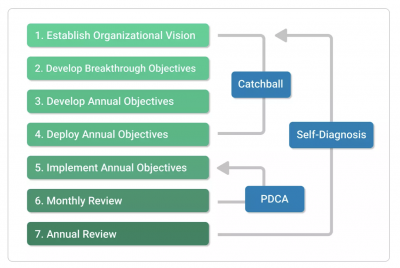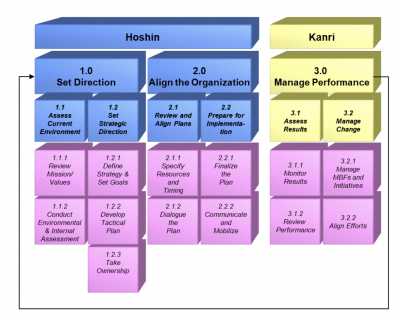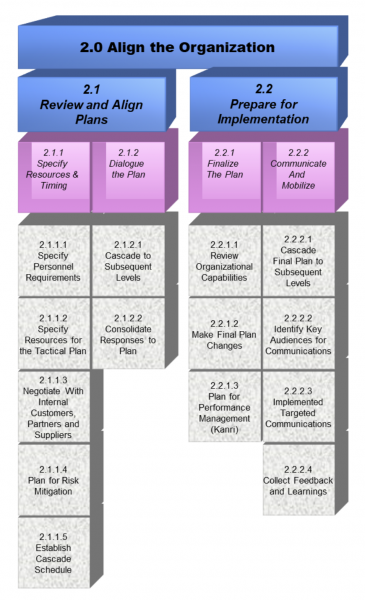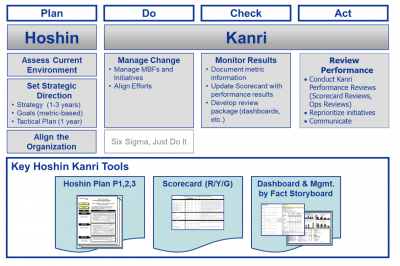
Hoshin Kanri is a closed loop management process where feedback is critical for guiding an organization’s planning, deployment, and execution of its most important business objectives. In this article, you will learn what Hoshin Kanri is, the seven steps of the Hoshin process, its benefits, and some tips on how to implement it in your organization.
Overview: What is Hoshin Kanri?
Hoshin Kanri is a management technique first developed in the 1950s by Professor Yoji Akao, a Japanese planning specialist. He believed that “Each person is the expert in his or her own job, and Japanese TQC [Total Quality Control] is designed to use the collective thinking power of all employees to make their organization the best in its field.”
Hoshin is loosely translated as direction or compass needle and refers to setting direction and alignment of resources. Kanri means control or management. Therefore, Hoshin Kanri together helps you set direction and manage your long-range goals. Simply put, Hoshin Kanri is the way you ensure everyone in the company is working towards the same strategic goals. Hoshin Kanri is also referred to as Policy Deployment and Hoshin Planning.
The distinctive elements of Hoshin Kanri as a strategic planning and management methodology are:
- Focus on breakthrough to world class performance
- Obsession with alignment – horizontal and vertical
- Deployment to an annual plan
- Integration with ongoing management processes
The 7 steps of Hoshin are shown in the graphic below:

You will also note in the graphic above the use of the terms Catchball and PDCA. A crucial element of Hoshin is that the process is not executed strictly top-down. In reality, it is a joint effort of back-and-forth feedback between a manager and a direct report. They have to mutually agree on the optimal set of goals.
The back-and-forth communication and feedback is the essence of Catchball just like the back and forth of tossing a baseball.
The Deming Cycle (PDCA / PDSA) is a model for continuous improvement and is a critical element of Hoshin. It consists of four steps:
- PLAN – Plan an experiment and forecast what the results will be
- DO – Implement the plan
- CHECK – Validate the hypothesis
- ACT – If successful, standardize the experiment results and restart the sequence
5 benefits of Hoshin Kanri
There are many benefits of using Hoshin Kanri as the method for developing your strategic plan. Here are a few of them.
1. Aligns operational activities with organizational vision, goals, and objectives
Hoshin starts with establishing your organization’s vision. Your goals and objectives need to roll up to that common vision.
2. Encourages commitment and buy-in throughout the organization
When people are involved in the decision-making and design of the plan, it will be easier for them to get behind it and push for it to become a reality.
3. Results in both strategic and tactical plans
When using Hoshin, high-level goals and objectives are broken down to actionable tasks and activities and cascaded down to each level in the organization. Having this holistic view makes Hoshin an effective strategic and tactical planning tool.
4. Empowers employees and encourages personal ownership of the plan
Not only does involving employees in the decision-making and planning process encourage commitment and buy-in, it also empowers them and increases their sense of ownership towards the business.
5. Constant communication leads to continuous improvement
The Hoshin Catchball process ensures feedback loops are established. Monthly, quarterly, and annual reviews allow teams to track their progress against the target goals and objectives. If there are gaps between where they are and where they should be, it’s faster for the team to adjust and pivot when needed.
Why is Hoshin Kanri important to understand?
Given the power of Hoshin Kanri in developing your strategic plan, there are a number of important things you should understand about its use.
Strategic planning should not just be a top-down activity
To optimize your strategic plan, it is best to solicit feedback and ideas from all levels of the organization. While the high-level strategic imperatives should cascade down, the details and recommendations for execution should flow up and sideways. “Catchball” is the phrase and concept used in Hoshin Kanri for accomplishing this.
Macro to micro
The value of Hoshin Kanri is to enable your senior leaders to break down high-level, long-term business goals into more micro actionable activities. Doing this allows your organization to incrementally achieve its goals. This also ensures all the activities your company engages in will be in support of your long-term goals.
Alignment
Hoshin Kanri strives to get every employee pulling in the same direction at the same time. It achieves this by aligning the goals of the company (Strategy) with the plans of middle management (Tactics) and the work performed by all employees (Operations).
An industry example of Hoshin Kanri
A large international financial organization decided to try using Hoshin Kanri to develop its strategic plan in lieu of using its more traditional approach. They adapted the 7 steps of Hoshin Kanri and consolidated them into three components. See the graphic below.

They further broke their plan into more detailed activities, as shown below:

Previously it has been mentioned that continuous improvement and the use of PDCA are important components of Hoshin Kanri. The graphic below illustrates how the organization integrated PDCA into their process.

Note the mention of something called MBF. This stands for Management by Fact. KPIs and metrics are an important part of any Hoshin plan since it is the method by which you track how the organization is doing in its quest to achieve its objectives and goals.

Finally, here is a process flow of the organization’s Hoshin Kanri process.

3 best practices when thinking about Hoshin Kanri
Since implementing Hoshin Kanri is a complex and time-consuming process, here are a few tips for making the transition a bit easier.
1. Start at the top
Senior leadership has the responsibility for initially developing the high-level, strategic imperatives for your organization. These should be carefully written to address a small number of critical issues. Don’t attempt to boil the ocean or solve world hunger.
2. Seek input
Don’t execute Hoshin Kanri in isolation. Involving others will give you these benefits:
- It provides additional perspective and feedback that helps craft stronger, more informed strategies.
- It creates a sense of shared responsibility for the plan and significantly more buy-in from middle management and below.
3. Carefully select your metrics and KPIs
Key Performance Indicators (KPIs) provide the mechanism for tracking progress toward your goals. They also have a considerable ability to drive behavior, so choose your KPIs with care. It is important to evaluate whether your selected KPIs will drive the desired behavior without any unintended consequences.
Frequently Asked Questions (FAQ) about Hoshin Kanri
1. What does Hoshin Kanri mean?
Hoshin is a Japanese word meaning direction or compass needle. Kanri means control or management. This describes the purpose of Hoshin Kanri which is to let the strategic goals of the organization guide every decision and action.
2. What is a simple explanation of Hoshin Kanri?
Hoshin Kanri is a closed loop management strategy that begins with an annual strategic plan developed by senior level management. The goals of the plan should be limited (5 goals or less as best practice), focused on effectiveness, and agreed upon by all levels of management to ensure they are realistic and achievable.
3. How is Hoshin Kanri different from traditional strategic planning?
The benefits of Hoshin Kanri compared to traditional strategic planning include: integration of strategic objectives with tactical and operational management, the application of continuous improvement, parallel planning and execution methodology, organization wide approach, improvements in communication, increased consensus and buy-in to goal setting, and cross-functional-management integration.
Hoshin Kanri review
With Hoshin Kanri, organizations are driven to have both a macro and micro perspective when doing strategic planning. This is achieved by using the hierarchical relationship between goals and objectives as they cascade from one organizational level to another.
A major strength of the Hoshin Kanri method is a focus on a collective approach to planning. Unlike other planning methods done solely as a top-down approach by management, Hoshin Kanri involves all levels in the organization. This is achieved through a method called catchball. Ideas are passed between employees and managers until a consensus is reached. All inputs and ideas are incorporated in the final plan, and this is what everyone executes.